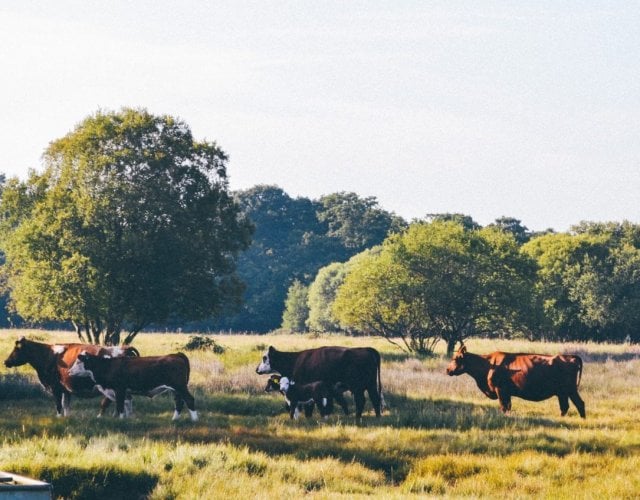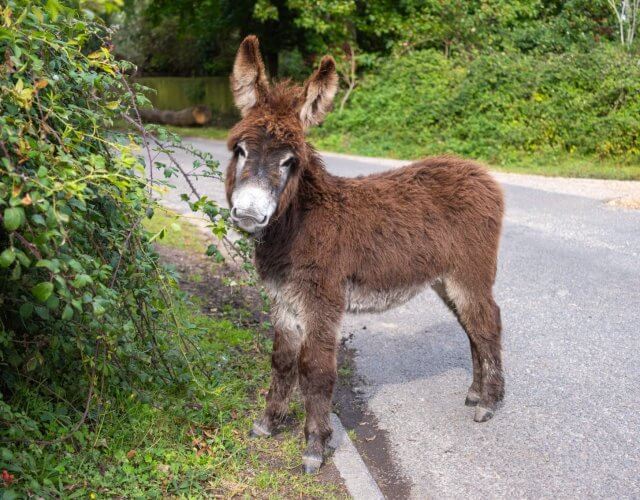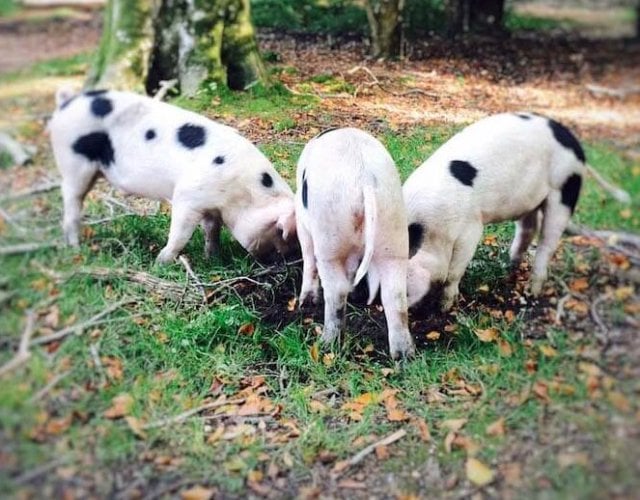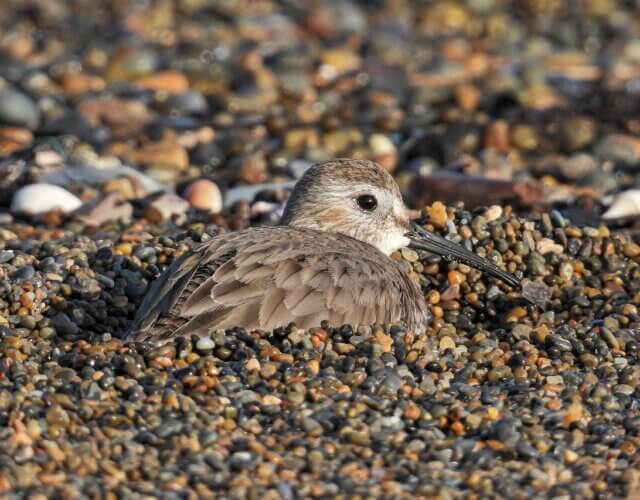
With rich environments of ancient woodland, heathland and wetlands, the
New Forest has long been a haven for a glorious range of wildlife. No matter
where you end up exploring, you’re bound to come across more than a few of
the forest’s animal residents!
When you stay in one of our New Forest holiday cottages, you’ll have plenty of
chances to spot some of the area’s most beloved animals. Our wildlife guide
covers what you can expect to see and the best places to do so.
Perhaps one of the most well-known things about the New Forest is its free- roaming animals. Thousands of animals (owned by ‘commoners’) are allowed to roam the open forest and surrounding areas as they please, leading to plenty of potential encounters on your travels.

New Forest Ponies, donkeys, pigs, cattle and sheep can all be seen throughout the New Forest at different times of the year, with ponies roaming year-round and pigs being set out for Pannage in autumn. While these animals are owned by someone, they are not tame, so it’s best to keep your distance as you would when spotting any other kinds of wildlife.
Other animals and wildlife that call the New Forest home include:
// Deer – including, red, roe, fallow, sika and muntjac deer.
// Around 100 species of birds – including rare birds such as the nightjar, Dartford warbler, woodlark, wood warbler, skylark, curlew, lapwing and more.
// Reptiles & amphibians – including adders, grass snakes, and sand lizards, as well as frogs, toads and newts in the wetland and bog areas.
// Woodland animals – including rabbits, voles, squirrels, foxes and badgers which you might spot when out on the forest trails.
// Otters – they’re quite rare but otters can be spotted along the coast and sometimes further inland.
// Bats – including at least 14 of the UK’s 18 species, with the most common to see being greater horseshoe, Bechstein’s and barbastelle bats.
// Insects – countless intriguing beetles, butterflies, dragonflies and more.
// Seals – including grey and harbour seals along the coast.
Some of these animals are much shyer than others, so don’t get too disheartened if you don’t see the more elusive species!

With so many animals and wildlife supporting the local ecosystem, the New Forest has a proud heritage of animal conservation. Its status as a National Park and the presence of Special Protection Areas, Sites of Special Scientific Interest and other conservation areas mean that lots of resources go into the protection of the forest’s landscapes and animal habitats.
Important conservation work means we can continue enjoying everything that makes the New Forest so special and ensure that the wildlife can keep thriving.
For more stunning locations that celebrate the natural world, see our guide on the best gardens to visit in the New Forest.

If you’re particularly keen to see lots of wildlife on your New Forest adventure, there are some key hotspots that’ll help you get the most out of your visit.
Whether you just want to get out and about in nature and see what you come across, or you want to head to a wildlife centre with a variety of animals to see and learn about, there are plenty of places to satisfy your inner animal lover.

As the name suggests, Bolderwood in the heart of the New Forest is one of the best places to see deer. A viewing platform overlooks an expansive meadow, offering some lovely photo opportunities when the deers make themselves known.
There are also three circular walks taking you through the ancient and ornamental woodland where you can take in the forest ambience.

The nature reserve at Lepe Country Park boasts a beach, wildflower meadows, woods and rugged pine-fringed cliffs, offering a range of rich natural habits for all numbers of creatures.
Take to the mudflats to see a range of birds including curlew, oystercatcher and plover. To the northwest, you might see the moorhen, heron and kingfisher visiting the ponds. The bird hide is a good spot where you can settle in and see a range of local bird life.
Lots of British woodland mammals also call the surrounding woods their home. Sometimes roe deer are seen roaming the park.
Exploring the various woodland trails is one of the best ways to experience the New Forest and see its varied flora and fauna. Blackwater Arboretum between Brockenhurst and Lyndhurst offers some particularly beautiful walks and a chance to get up close to nature.
Here you’ll see majestic Douglas fir trees, redwoods and Giant Sequoias. Enjoy the bird song from a chorus of birds found in the area, including the hawfinch, bullfinch, siskin, treecreeper, nuthatch and much more. You may also encounter some free-roaming ponies and cattle depending on the time of
year.

The Roydon Woods Nature Reserve just down from Brockenhurst is similarly rich with animals and plant life, making for a lovely stroll interspersed with a bit of bird watching and wildlife spotting.
The woods are full of birds and typical woodland mammals, including the woodpecker, skylark and nuthatch, and voles, stoats, badgers and even deer. The woodland floors are blanketed in colourful flowers, which attract a plethora of butterflies and other insects. Roydon Woods is particularly celebrated for its gorgeous blooms of bluebells in spring.
The Lymington and Keyhaven Nature Reserve is made up of coastal marshes, mudflats and salt marshes that are home to countless fish, marine life and various seabird species.
The reserve here is a real haven for birdwatchers – you’ll often see little egret, teal and little tern in the lagoons, as well as curlew, sandpiper, dunlin and various warblers. You might also see birds of prey such as the marsh harrier, merlin and peregrine falcon.

The Reptile Centre near Lyndhurst provides a fantastic opportunity for you to get up close with the area’s native reptiles and amphibians. Here, you can see special conservation ‘pods’ and natural habitat enclosures that serve as homes for a range of animals, including frogs, sand lizards, adders and smooth snakes.
These animals can be quite elusive in the wild, so the centre offers a chance to see these interesting creatures while performing important conservation work. The Reptile Centre is only open seasonally, so make sure you check the timings before making a trip.
The New Forest Wildlife Park is an absolute must-visit for animal lovers. The park is home to over 260 individual animals (across 40 species), including native wildlife and animals from around the world. With conservation and education at the heart of everything the site does, there’s so much to see and
do when you visit.
Animals you can see include otters, owls, wildcats, wolves, deer, bison, wallabies and more. With various keeper talks and feeding time shows, you’ll have the chance to learn all about the fantastic animals and the other wildlife that call the New Forest home.
If you’re particularly keen to spot some New Forest ponies on your travels, you usually won’t have to look too far, no matter where you’re staying! However, for some known pony hotspots, see our full guide to the New Forest ponies.

We’re proud to offer an eclectic range of holiday cottages across the New Forest, with forest retreats, seaside spots and countryside getaways that’ll ensure you’re never too far away from all the action.
Can’t wait to see some of the New Forest’s wildlife for yourself? Book your escape today.